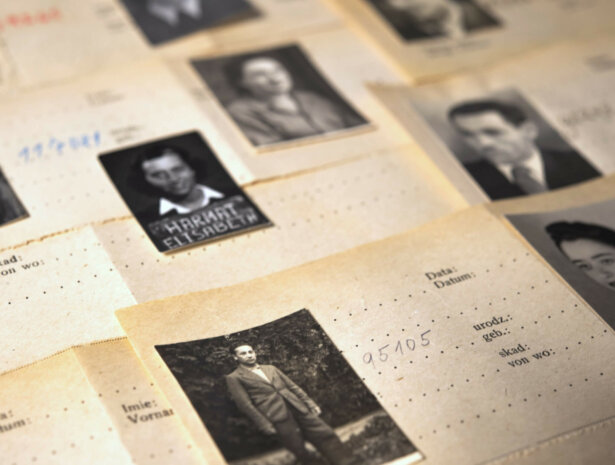Search & Explore
Are you looking for information about relatives who were persecuted during the Nazi period? Are you doing research on National Socialist persecution or planning an educational project on this topic? The Arolsen Archives have the largest collection of information on Nazi victims, including documents on concentration camps, forced labor and displaced persons. There are three ways of accessing the archive: search the online archive, send us an inquiry or come and visit us in person.
FAQ
The Arolsen Archives are continuously publishing more and more parts of their collection online. Because it has been recognized by UNESCO as part of the world’s documentary heritage, the largest archive on the victims of Nazi persecution must be made accessible to the world. Historians, descendants of the Nazis’ victims, teachers and other interested parties can already find several million documents on the Nazi period in the online archive. The digital holdings on concentration camps, ghettos and Nazi penal institutions are particularly comprehensive. Personal documents on individual prisoners can be found there. The collection from the Dachau and Buchenwald concentration camps is particularly extensive, as are the lists of names from transports between different locations.
The files on Displaced Persons, created shortly after the end of the Second World War, are well indexed and therefore easily searchable. They include, for example, questionnaires from the IRO (International Refugee Organization). Particularly noteworthy is the collection of personal effects. The Arolsen Archives still hold almost 3000 envelopes containing objects which were taken from concentration camp inmates. You can see photos of these personal belongings in the online archive – often these were the very last possessions the people still had.
The Arolsen Archives have 30 million original documents on the victims of Nazi crimes. For decades, staff used these documents to help them search for people and not as an academic archive. So indexing the masses of heterogeneous files and preparing them for online publication requires a lot of time and effort. The Arolsen Archives do not describe their sub-collections right down to the smallest detail, but see it as their duty to publish them within a reasonable length of time. This applies especially to holdings which are of particular public interest, such as concentration camp files, for example.
By working in this pragmatic way, the Arolsen Archives have already managed to publish several million documents in the online archive since 2015. These documents range from materials which have been very carefully prepared, such as the files on death marches which come complete with a map featuring a search function, to materials which are only available in scanned form and are therefore not searchable, such as transport lists. We are involved in a number of indexing projects with various partners in order to continuously improve the digital topic and name search functions.
At present, the online archive is only an excerpt of the whole collection and will remain so for the coming years. Whether your search in the online archive was successful or not, you should always send a parallel inquiry to the Arolsen Archives if you would like to receive more complete information. The Arolsen Archives team works with a digital version of the Central Name Index and has other search options which are not available in the online archive.
The Arolsen Archives are happy to deal with simple inquiries for you, such as research on the fate of individual victims or manageable thematic inquiries: Just fill in our inquiry form! We are also happy to check in advance whether it would be worthwhile for you to visit the archive in order to conduct research in person.
For more complex academic projects you should register for a visit. Visits can also be arranged for groups. Our staff are happy to answer any questions you may have in advance of your research visit to the archive. You can also view the complete digitized holdings at a number of partner institutions located across the world.
The Arolsen Archives have gradually been publishing their digitized holdings in the online archive since 2015. However, many of the documents are not yet available on the Internet, but can only be accessed on site or in some of the member states which belong to our International Committee. These member states can provide access to their copy of the digitized holdings to ensure that these important documents on Nazi persecution are made available to as many people as possible worldwide. Academics, the families of the victims of Nazi persecution and other interested parties can find the annually updated files here:
- Belgium: Archives de l’État en Belgique, Brussels
- France: Archives Nationales, Pierrefitte-sur-Seine
- Israel: Yad Vashem, Jerusalem
- Luxemburg: Ministère d’Etat/Présidence du Gouvernement – Service de la Mémoire de la Deuxième Guerre Mondiale, Luxemburg
- Poland: Instytut Pamięci Narodowej (IPN), Warsaw
- USA: US Holocaust Memorial Museum (USHMM), Washington
- United Kingdom: The Wiener Library, London
Not only is the collection of the Arolsen Archives on Nazi persecution and the consequences of National Socialism the largest in the world, the heterogeneity of the documents is also a notable feature. It makes them particularly interesting, but also presents users with a challenge. The general inventory provides a comprehensive overview. You can use it to assess the availability of documents relevant to your project. Before visiting the archive in Bad Arolsen, you can conduct initial research on your topic on this basis. Basic information on our sub-collections is provided in German and English: especially the title, scope, signature and keywords on the content. You can use the structure or the keyword search.
Finding aids and specialist inventories of the Arolsen Archives provide information on individual sub-collections, but they were only compiled during a short period of time. In the initial phase following the opening of the archive, efforts were made to create conventional finding aids for the various sub-collections. However, it soon became apparent that updating and further developing the online catalogue was a more useful tool, as it can be used conveniently for keyword searches worldwide.
Finding aids exist on the following topics:
Child Search Branch
“Generalbauinspektor für die Reichshauptstadt” (Construction Inspector General for the Reich’s Capital)
Files of the “Geheime Staatspolizei” (Gestapo)
Documents of the SS Organization “Lebensborn”
Courts Martial of the German Army
Allied Military Tribunals
“Verwaltungsamt für innere Restitutionen” (Administrative Office for Inner Restitutions)
Records on Death Marches (Special Inventory)
Non-Inventoried Acquisitions
Westerbork Collection
Nazi persecution in the Benelux countries
Card Index of the “General Documents” of the collection Incarceration and Persecution






